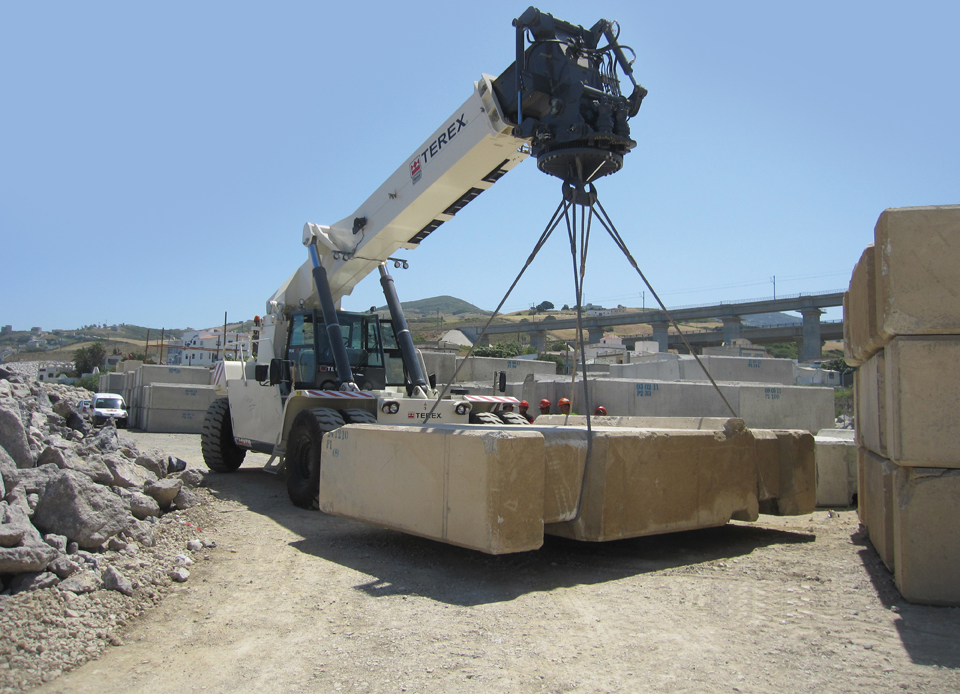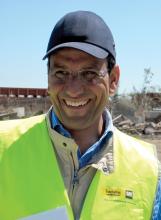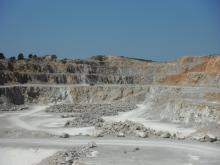
Phase II construction of Morocco’s Tangiers Med port development project is well underway
A
The machines delivered to Bouygues by
Commissioned by the Tangiers Mediterranean Special Agency (TMSA), and described as one of the largest infrastructure projects ever to be undertaken in Morocco, the future deep-water port and associated free trade zone is located 35km east of Tangiers on the Mediterranean coast. This is a strategic intersection where major north-south and east-west shipping lanes meet in the Gibraltar Strait, just 14km across from the Spanish Port of Algeciras.
Aiming to become the Mediterranean region’s key port and hub for container shipments to and from America, Europe, the Middle East and Asia, Tangiers Med Phases I and II will ultimately comprise five terminals for container vessels, passenger ships and oil tankers, including three logistics, commercial and industrial free zones.
The AC 40 Optimax, a 40tonne capacity class crane, and the TFC 45 reach stacker, equipped with a rotating hook instead of the standard spreader, are being used to assist in the construction of a massive, 2km long, 37m high sea wall that will protect the port and docks from the open sea.
Bouygues was awarded the contract to build this crucial element of the port’s structure on the basis of an economical and environmentally-friendly solution using 7,500 cast-concrete Accropode units (patented by SOGREAH for the protection of port sea walls and coastal structures) and 40 reinforced, sand-filled caissons. The structure will enable the port’s overall area to increase by approximately 18 hectares.
Built over a quarried stone embankment, the caissons are sunk 20m deep to form the centre of the sea wall.
The Accropode units are placed on the sea-facing side of the barrier, in shallower waters, as protection against breaking waves and the subsequent effects of erosion. This alternative offers significantly lower environmental impact, and will enable the construction to be completed more rapidly by reducing the quantities of material required to build the huge barrier from 21 to 7 million tonnes.
Special quarry
During Phase 1, construction of the breakwater and of the caissons required a quarry to be opened and operated near the port.
It supplied aggregate and sand for concrete and also material for the rubble-mound breakwater and its rock armour.
The 8km long specially-built haulage road to the port was used 24-hours-a day for the 500 return trips and the 50 trucks drive daily. A total of close to 10,000tonnes of construction materials had to be hauled to the site every day.
“From work in the stone quarry, loading and unloading tonnes of gravel and sand for concrete-making, to assisting in the erection of other cranes or moving equipment around the jobsite, the new crane model has proved to be extremely reliable and productive in heavy general handling duties,” says Bouygues.
The Terex TFC 45 is also working at another jobsite location. Cast in concrete on-site, then transported to another area where they are stored and left to dry, the Accropode units are produced at the rate of 30 a day. Made in sizes ranging from 4-16m³, the heaviest units weigh up to 40tonnes. Once they have dried, the TFC 45 is used to lift and carry the blocks to trucks, then transport them to the sea front where they are placed into their final position by a larger crane.
“Built to lift and transport heavy loads rapidly, the Terex TFC 45 reach stacker is specially adapted to work with a rotating hook attachment to stock, carry and load Accropodes, which form the final protective barrier of the port’s sea wall.
“This is exactly what we need here in Tangiers to complete the job within a rapidly approaching 2012 deadline,” says As M. Anas, equipment purchases manager.
Once the Terex TFC 45 has fulfilled its role constructing the port, it will be able to be converted on-site by Vemat’s technicians to take on a new function using a spreader in one of Tangiers Med’s new container port terminals.
The Terex AC 40 Optimax offers a maximum lifting capacity of 35tonnes at 3m radius, while its synchronized telescopic boom (available with three or four sections) can be extended rapidly to provide a maximum reach of up to 23.4m. The TFC 45 reach stacker offers maximum lifting capacities up to 45tonnes.










